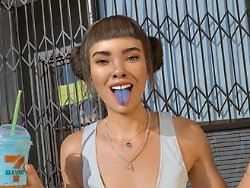She is 19 years old and leads a life that many dream of. The internet phenomenon Miquela has nearly three million followers, has released several songs and looks like a top model. However, the slim girl is an illusion – her creators make millions from her.
The advertising budgets for social media advertising are getting bigger and bigger: Last year companies invested around 80 billion euros in advertising on social networks. Part of this growing cake ends up in the coffers of so-called "influencers" who advertise products and services on their channels. Many people follow influencers because they are funny, inspiring or simply beautiful – the advertising appears to be incidental. Kylie Jenner, a 23-year-old member of the Kardashian clan, has already earned hundreds of millions of euros from her social media activities.
In any case, the American's Instagram profile has the same target group as Miquela's. Accordingly, the profile with the name "lilmiquela" looks similar: Sometimes the face of a 19-year-old with a milkshake in her hand and tongue out, grins at the camera. Then she photographs herself in high fashion clothes in the mirror. And in some photos, she looks lightly dressed and with a seductive look into the eyes of her followers.
But in contrast to Jenner, she is not a real person, but the product of an artificial intelligence. The website onbuy.com has calculated that its creators turn over around 6500 euros – per post. With 847 posts, that adds up to a proud sum. The onbuy.com team predicts the creators will have annual sales of almost $ 9 million.
They do not reveal how much the virtual fathers really earn with their “robot influencer” daughter. It is obvious, however, that your idea should be very profitable: With the help of your software, you have created an influencer who you can put perfectly in any imaginable scene with just a few clicks. The design of her protagonist tends to be a mix of beauty idealistic mass suitability and small flaws like a tooth gap. It's a look that apparently many of the 2.7 million followers can identify with: The US American "Time" magazine named Miquela one of the 25 most influential people on the Internet last year.
Influencer robots don't have to be credible
Its creator, a technology startup called Brud, does everything to make Miquela appear like a real person. She advertises handbags by noble designers, makes selfie videos of her apartment or shows up on the couch on Sundays. She campaigns for the Black Lives Matter movement and posts photos of her "behind the camera" – if you read her captions and scroll a little faster through her profile, you could almost think: this is a completely normal influencer.
Only the word "robot" in her self-description suggests that her two twisted braids – her trademark – are not real. On videos, however, she is more reminiscent of a video game character than a young girl.
In interviews, journalists or marketing people ask "real" influencers about their recipe for success. Slogans like "realness" or "authenticity" are often used in their answers. In fact, surveys show that credibility is the most important quality of a successful Instagram channel.
How then does the fake influencer arrive with the users? A Look at the comments shows: Many honor the creativity of their creators, are impressed by the versatile, always perfectly exposed images. "Coding something like this is very demanding," says one, while others simply describe the humanoid as "beautiful." However, experts doubt that Miquela comes from a purely virtual world: the details of the photos are too perfect for that. Some assumptions suggest that real people can be photographed and that the image is only transformed into Miquela on the screen.
Why the robots are dangerous
In addition to Instagram, their makers have now opened up another business area: Youtube. Their videos are similarly successful there, they have already been viewed more than 30 million times. In terms of content, the clips hardly differ from other "lifestyle" youtubers. Miquela sings, reports on her feelings in video blogs and takes part in challenges. Here, too, companies use their attention for product placements and commercials.
"As an influencer, you can earn the most money with posts on these two channels," says Erwin Lammenett of "Die Zeit". He advises companies that advertise on the Internet and has written a book on how companies use influencers. Virtual trendsetters like Miquela are well suited for companies that want to advertise their products: "I can control an artificial influencer much better than a person," explains the expert and emphasizes: "When the lively influencer says something that I don't like "As a company, I can't do anything about it. The robot influencer doesn't have an opinion of his own."
Because the artificial figures are so popular, there are now a large number of similar profiles. This also includes the Instagram channel "noonoouri", which is operated by German programmers and already has over 360,000 followers.
Wolfgang Kreissig thinks that is dangerous. He is the chairman of the commission for the protection of minors in the media: "It's not good for children if they think robots like Miquela are real, because children like to trust influencers and often see them as role models," explains the youth welfare advocate of "Die Zeit". This is particularly worrying when it comes to unrealistic body images or sending political messages. However, it is still unknown whether adolescents and children emulate a non-existent person actually has negative consequences. There are no well-founded studies on this.
.
